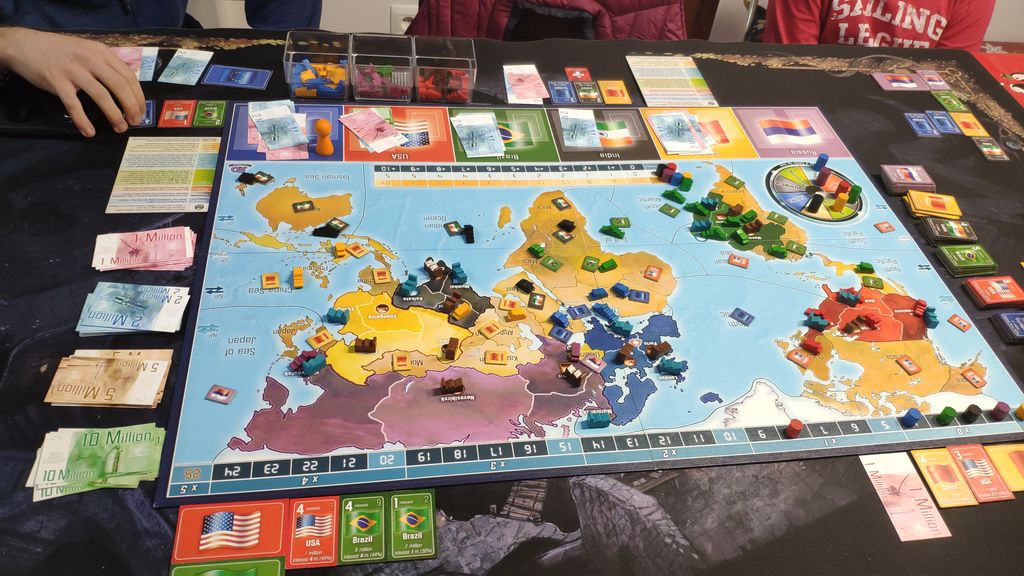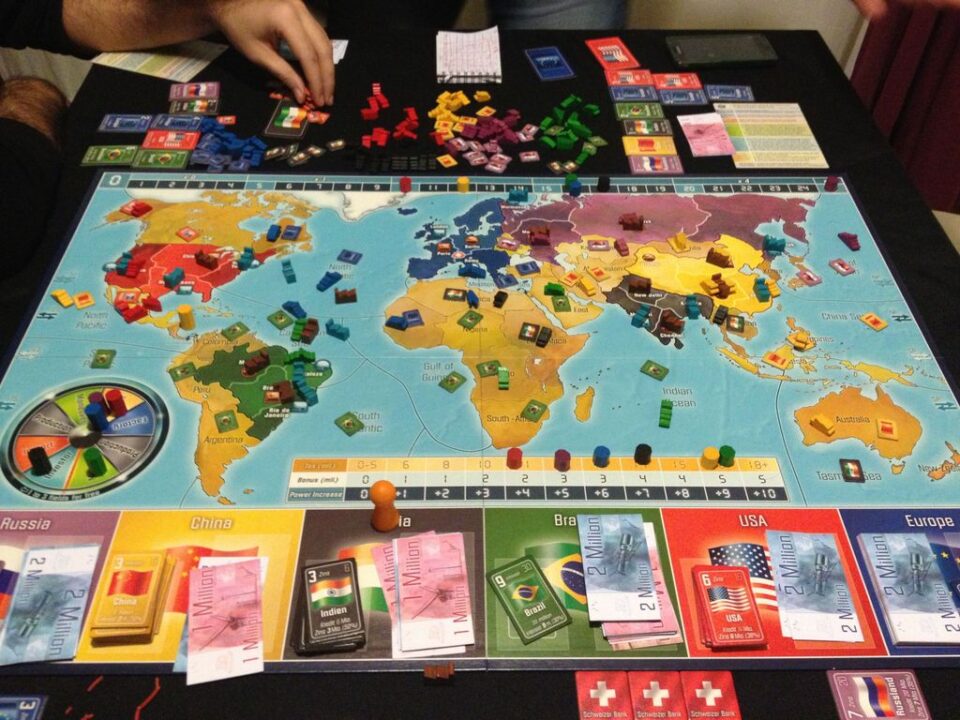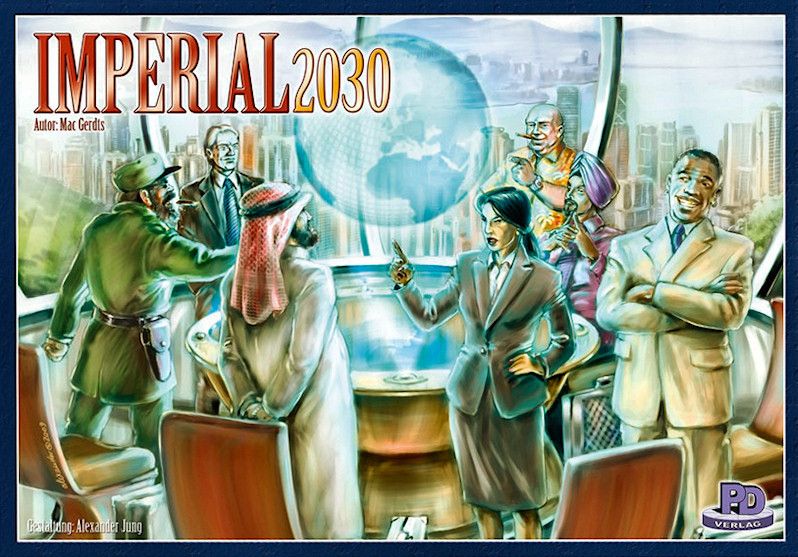Overview
Welcome to our board game corner where we place the intricate dance of economics, warfare, and diplomacy under the magnifying glass. Today, our focus turns to the grand strategy game of Imperial 2030, an intriguing globe-spanning contest of supremacy. Through the looking glass of our review, we prod the game’s entangled system of global economic influence and intricate rule complexity. By unpacking the mechanics that bolster the strategic interaction among players, we aim to dissect the experience holistically. Fasten your seat belts, strategists – this review is set to weave through the geopolitical tapestry of Imperial 2030, interlocking finance, friendships, and the cerebral tapestry of becoming the dominant superpower of tomorrow.
How It Plays
Setting Up
To set up Imperial 2030, place the game board in the center of the table, representing the world with varying great powers. Players are investors who will control nations by purchasing government bonds. Distribute the respective nation’s units, factories, and money as outlined in the game’s rules. Each player starts with a specific sum of money to invest in the powers they wish to control.
Gameplay
During gameplay, players take turns steering the actions of the powers they control by investing in them, aiming to expand their influence and yield high returns. Moves are strategic, involving troop movements, tax collection, and engaging in wars. Money in this game represents points, and actions often revolve around managing investments and banking on the right nation at the right time.
Winning the Game
The game concludes when a nation accomplishes the all-important bond majority, leading to a taxation round that ends the session. Players calculate their wealth based on the bonds they hold and cash in hand. The one with the highest total is declared the supreme investor and, thereby, the winner.
Want to know more? Read our extensive strategy guide for Imperial 2030.
Commanding Global Economies in Imperial 2030
Strategic Market Manipulation
In our Imperial 2030 Review, we delve deep into the game’s ability to masterfully simulate global economic influence. Players must vie for control over countries, each acting as corporations in a global market. Here, the game shines, urging strategic investments and ruthless financial maneuvers. Moreover, the economic tides shift with every military move, which means players are constantly adapting.
Fiscal Dominance and Power Plays
Through loans, taxation, and funding armies, you feel the weighty clout of economic decisions. Having such a profound fiscal toolset at your disposal ensures a dynamic spreadsheet of opportunities and challenges to overcome, with the savviest tycoon often reigning supreme.
As you marshal your financial empire, anticipate the seamless transition into the next gripping chapter of gameplay: Strategic Interaction among Players.

A Tense Diplomatic Chess Game
Shifting Alliances and Negotiations: In my Imperial 2030 Review, I highlight the intense social dynamics at play. The game excels as subsections of allies inconspicuously form, often quietly drafted over whispered promises of power-sharing. Subsequently, treacherous betrayals are not just common; they’re an expected art form.
Collaborative Rivalries : What begins as a cooperative venture can swiftly escalate into a querulous territory dispute, clearly illustrating Imperial 2030’s merciless nature of player interaction. Clever card play and decisive movements set the stage for grand strategy unveiling.
Now, as we pivot our attention from alleyways to algorithms, let’s delve into the Rule Complexity and Depth that underpin this fascinating game.

Delving into Imperial 2030’s Ruleset
Navigating the Rulebook: In this Imperial 2030 Review, we’re diving into the enthralling complexity that underpins the game’s essence. Initially, the rules may seem daunting—an intricate web of investments, conflicts, and economics. Nevertheless, seasoned board gamers will recognize that this complexity engenders a deep strategic pool from which to draw. Mastery of these rules is tantamount to fluently speaking a new strategic gaming language.
Sophistication in Gameplay: Moreover, this elaborate rule structure isn’t complexity for complexity’s sake. On the contrary, it facilitates a nuanced depth of play, offering layered strategic decisions with each turn. Admittedly, there’s a learning curve here, but it’s a rewarding ascent. The crescendo of this complexity climaxes in moments where forethought and cunning strategies alloy, producing immense satisfaction and replayability. Careful rule examination unearths a deliberate balance, rewarding players who keenly navigate its depths.
In conclusion, for those who willingly dive into its sophisticated mechanics, Imperial 2030 is a board game that offers both cerebral and visceral rewards. Therefore, to the tacticians seeking a challenge and a masterclass in game design, I wholeheartedly recommend Imperial 2030.
Conclusion
As we draw the curtain on this review of Imperial 2030, we’ve delved through the dense thicket of its global economic mechanics, navigated the turbulent waters of strategy amongst players, and plumbed the profound depths of its rule complexity. This game is not merely a board to be played on but a cerebral journey, balancing the fulcrum of savvy investments with the deft touch of negotiation. Is it for everyone? Perhaps not—its intensity is not for the faint of heart. But for those reveling in strategic depth and interactive gameplay, it’s a resounding recommendation. Board game aficonados, this is a world stage not to be missed.


